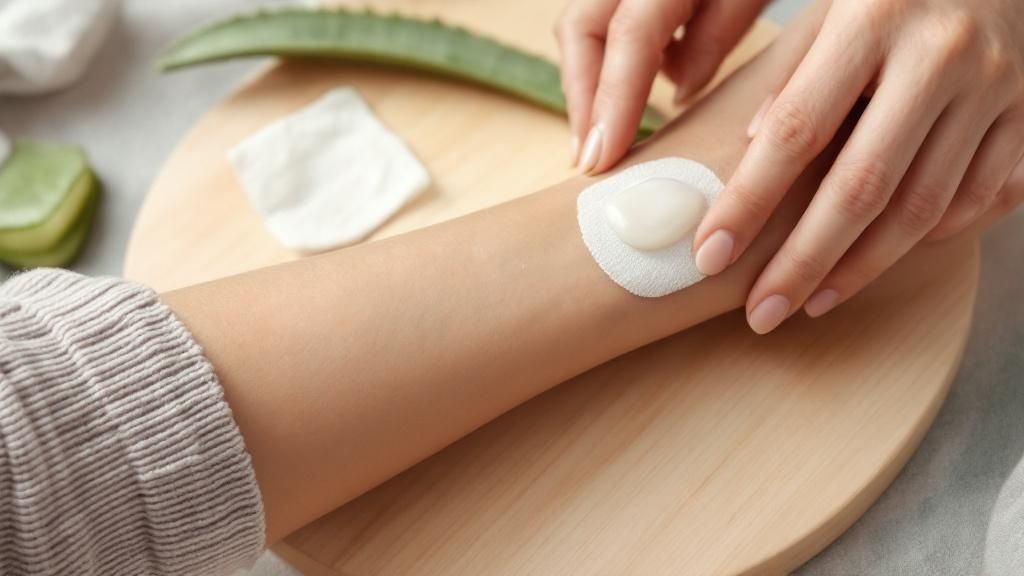If you want to heal your skin as quickly as possible, what you do in the first few minutes after an injury matters most. How you clean the wound and protect it from bacteria right away sets the entire pace for recovery. Get it right, and you can dramatically shorten healing time and sidestep complications.
Your First Moves for Rapid Skin Recovery
When you get a cut, scrape, or burn, your body instantly kicks off a complex healing process. Supporting that process in the first few hours is like giving your body a head start in a race—a better start leads to a stronger finish. The two most important goals are to prevent infection and create the best possible environment for repair.
This isn't just about slapping on a bandage and hoping for the best. It’s about a few deliberate actions that make a huge difference in how fast your skin heals. Skipping these early steps can let bacteria in, which often leads to infections that delay healing, cause more pain, and increase the risk of a nasty scar.
The Foundation of Fast Healing: Gentle Cleansing
The absolute first thing to do with any minor wound is to clean it, but how you clean it is critical. So many people reach for things like hydrogen peroxide or rubbing alcohol, thinking they're doing the right thing. In reality, these harsh chemicals can damage the delicate, healthy tissue around the injury, which actually slows down your body's healing efforts.
The best approach is surprisingly simple.
- Rinse with cool, running water. Let the water flow over the wound for several minutes. This is usually enough to flush out most of the dirt, debris, and bacteria without causing more damage.
- Use a mild soap. Gently wash the skin around the wound, not directly in it. The sudsy runoff is all you need to clean the area effectively.
- Pat, don't rub. Once it’s rinsed, gently pat the area dry with a clean cloth or, even better, a sterile piece of gauze. Rubbing can irritate the skin or even reopen the wound.
This gentle-but-thorough cleaning is your best defense against infection, which is the number one enemy of quick healing.
Understanding the Three Phases of Healing
Skin repair isn't a single event; it's a beautifully orchestrated sequence of three overlapping phases. This visual guide shows how your body methodically works to repair damage, starting from the moment of injury.
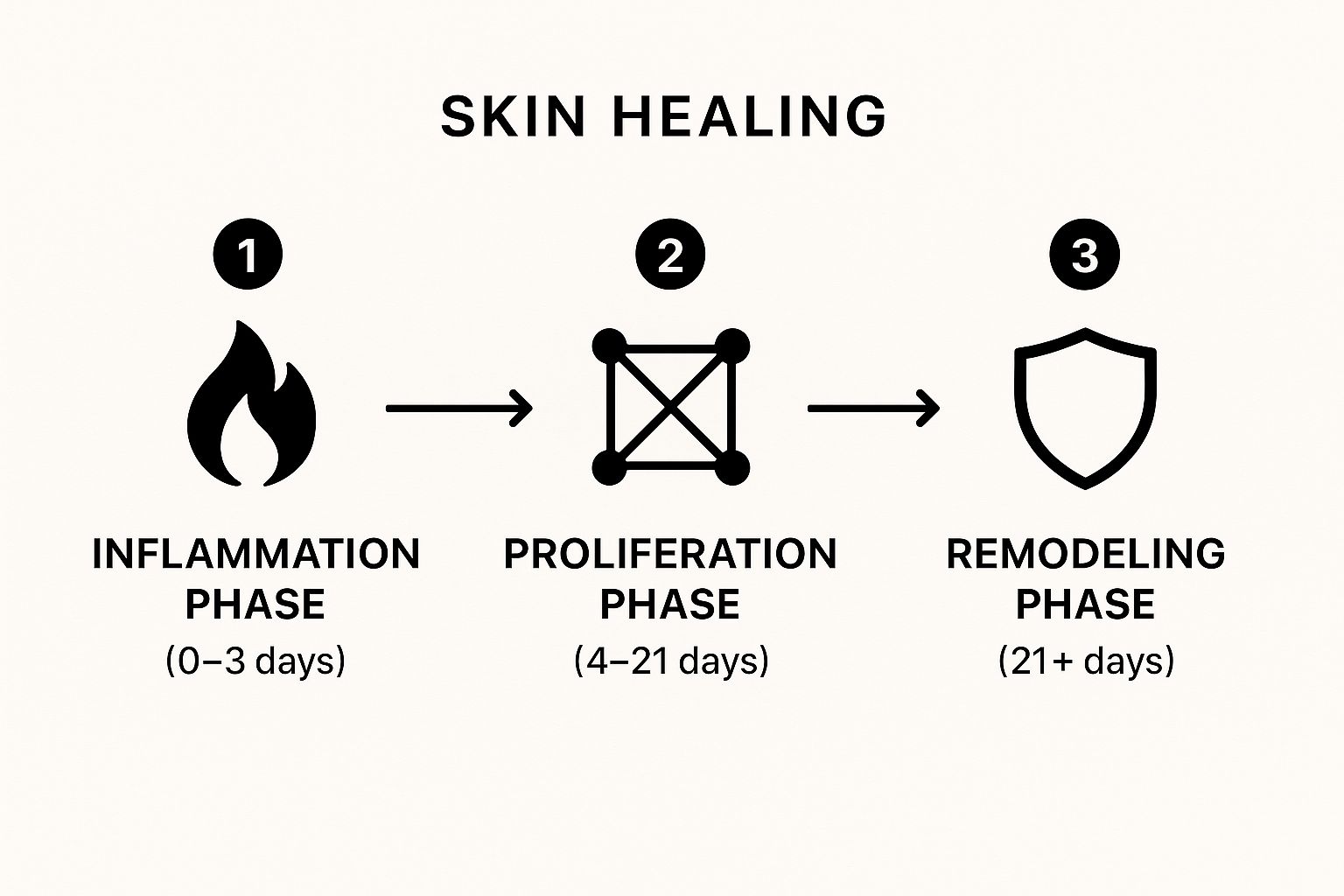
Seeing this natural progression helps you understand why that initial care during the inflammation phase is so foundational. It sets the stage for the rebuilding and strengthening that follows.
Choosing the Right First Aid
Once the wound is clean, your next move is applying the right kind of dressing. The goal here is to protect the injury while keeping it slightly moist. This is key, as countless studies have shown that a moist environment is ideal for cell regeneration.
Key Takeaway: We used to think wounds needed to "air out." We now know that's wrong. A covered, moist wound actually encourages faster cell migration and tissue growth, leading to quicker healing and less scarring.
For most minor cuts and scrapes, a simple adhesive bandage or a piece of sterile gauze taped down is all you need. If you have a minor burn, a non-stick pad (sometimes called a Telfa pad) is a much better choice because it won't stick to the delicate, healing skin.
To make it even simpler, here's a quick guide for the most common skin injuries.
Immediate Care for Common Skin Injuries
This table summarizes the best first aid steps to take right away, helping you promote fast healing from the very beginning.
| Injury Type | Initial Cleaning Method | Best First Dressing |
|---|---|---|
| Minor Cut | Rinse with cool water and mild soap around the area. | Sterile adhesive bandage. |
| Scrape/Abrasion | Gently flush with water to remove all dirt and debris. | Non-stick gauze pad or hydrocolloid dressing. |
| Minor Burn | Run under cool (not cold) water for 10-15 minutes. | Non-stick pad or specialized burn dressing. |
Following these initial steps correctly creates the perfect foundation for your body's natural healing powers to work at full speed. This is truly the fastest track to recovery.
Fueling Your Body for Faster Skin Repair
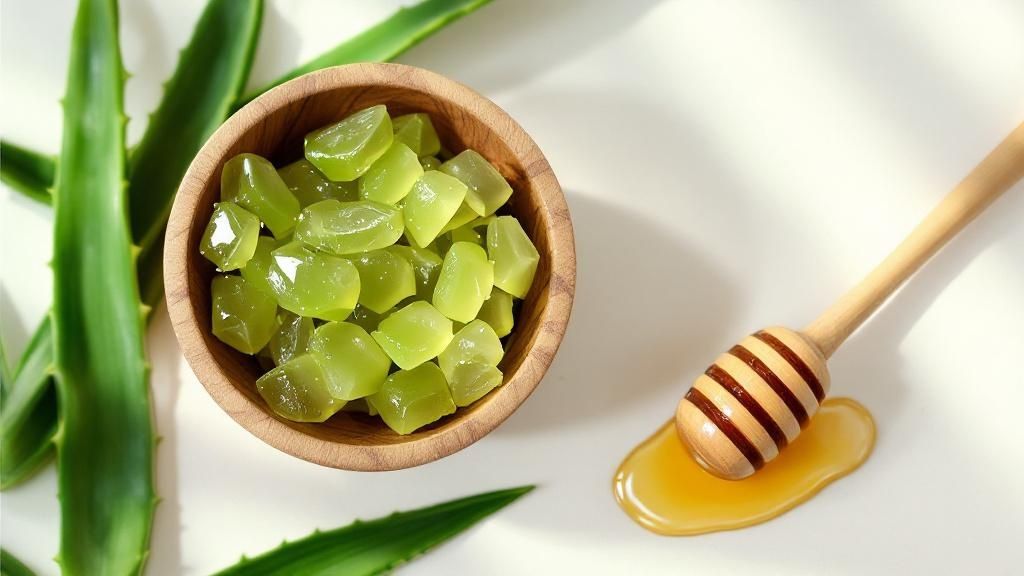
While everything you do on the outside of a wound creates the right environment for healing, the real work happens from the inside out. Your body is a remarkable machine, but it can’t build something from nothing. The food you eat provides the literal raw materials your body needs to create new tissue, fight infection, and calm inflammation.
I often tell my patients to think of it like a construction project. You can have the best crew and blueprints, but without bricks, steel, and mortar, you can’t build a wall. Your diet is just as crucial when learning how to heal skin fast. For more severe injuries, this becomes even more critical. Our guide on how to heal deep wounds faster dives deeper into this very topic.
The Essential Building Blocks for Skin
When your body is healing, its demand for certain nutrients skyrockets. Protein, for instance, is absolutely fundamental. It’s what your body breaks down into amino acids to weave together the collagen and other structural fibers needed to close a wound. If you’re not getting enough, the entire repair process grinds to a halt.
Vitamins and minerals are the foremen on this construction site—they direct the whole operation. They play a part in everything from keeping inflammation in check to building strong, resilient new skin.
- Protein: Absolutely essential for creating new cells and forming collagen.
- Vitamin C: A non-negotiable for producing that collagen. It also acts as a potent antioxidant, protecting fragile new cells from damage.
- Zinc: A powerhouse for immune function and protein synthesis. It helps your body build new tissue while keeping infection at bay.
Your Healing-Focused Shopping List
So, how do you get these nutrients? It's simpler than you might think. Just focus on whole, unprocessed foods. You don't need expensive supplements or complicated meal plans to create a diet that supports healing.
Here’s a practical shopping list to get you started:
| Nutrient | Food Sources | Role in Healing |
|---|---|---|
| Protein | Lean chicken, fish, eggs, Greek yogurt, lentils, beans, tofu | Forms the structural foundation for new skin and tissue. |
| Vitamin C | Oranges, bell peppers, strawberries, broccoli, kiwi | Essential for producing collagen, the 'scaffolding' of skin. |
| Zinc | Oysters, beef, pumpkin seeds, chickpeas, cashews | Supports immune defense and critical enzymatic reactions for repair. |
Stocking your kitchen with these items ensures you're giving your body a steady supply of the materials it's calling for.
A Note on Hydration: Don't forget water. Seriously. Every single cellular process, including wound repair, relies on it. Being dehydrated can slow nutrient delivery to the wound and bring your recovery to a screeching halt. Aim for plenty of water throughout the day to keep the assembly line moving.
Sample Meal Ideas for Rapid Repair
Putting it all together on your plate can be both easy and delicious. The key is to combine your protein, Vitamin C, and zinc sources to get the most out of their healing partnership.
Breakfast Example:
Try a bowl of Greek yogurt (protein) topped with a handful of fresh strawberries (Vitamin C) and a sprinkle of pumpkin seeds (zinc). It’s a simple way to start your day with a powerful healing boost.
Lunch or Dinner Example:
Think about grilled chicken or a hearty lentil stew (protein) served with a side of steamed broccoli and sliced red bell peppers (Vitamin C). This kind of meal refuels your body with exactly what it needs for afternoon and overnight repair.
By consciously fueling your body, you become an active participant in your own recovery. This internal support is the perfect partner for proper external wound care, giving you the best shot at healing quickly and completely.
Effective At-Home Wound Care Techniques
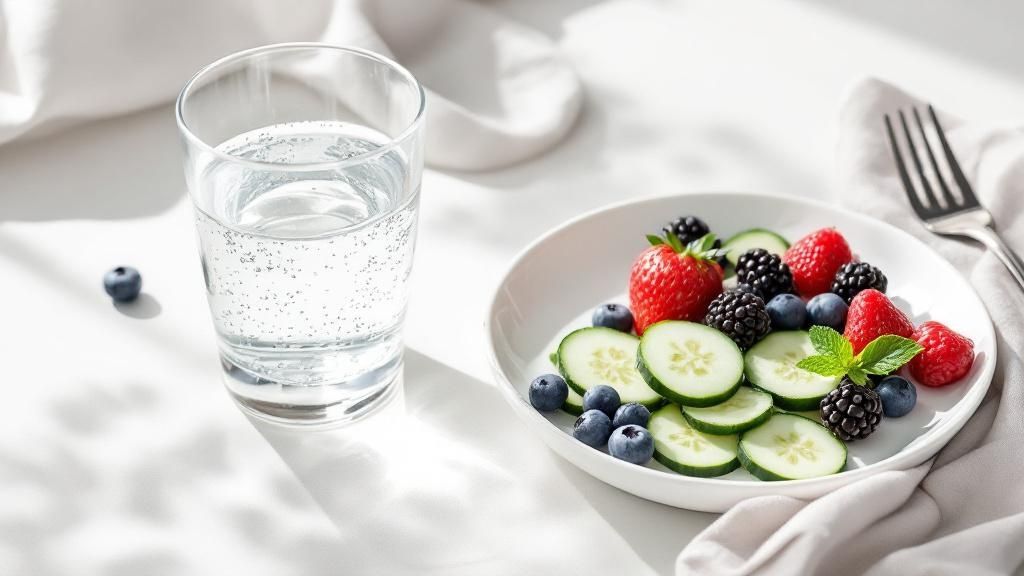
Once you’ve cleaned an injury and started fueling your body with the right nutrients, your focus needs to shift. The real secret to rapid recovery lies in creating and maintaining the perfect healing environment right at home.
This is where your daily habits can make or break the healing process. The techniques you use will either support your body’s natural repair crew or actively get in its way. Mastering a few key principles is a total game-changer if you want to know how to heal skin fast and sidestep any lasting marks.
The Myth of “Airing It Out”
Let's start by busting one of the most stubborn—and harmful—myths out there: the idea that you should let a wound "air out." For decades, the common advice was to let a hard scab form and leave it exposed. We now know this is one of the worst things you can do for quick, clean healing.
Modern wound care is built on a simple, powerful principle: moist wound healing. Think of it this way: the cells responsible for rebuilding your skin, called keratinocytes, are like tiny construction workers. They can move and work much faster across a moist surface. A dry, hard scab is a roadblock, forcing these new cells to waste time and energy burrowing underneath it. This dramatically slows everything down.
A covered, moist wound can speed up new skin growth—a process called epithelialization—by as much as 50% compared to a dry wound. This approach also helps soothe pain and reduce inflammation.
Keeping a wound properly covered does more than just maintain moisture. It shields the fragile new tissue from bacteria and accidental bumps, letting your body focus all its energy on rebuilding. Understanding how home wound care speeds up recovery is fundamental to getting the best possible outcome.
Choosing the Right Bandage for the Job
Not all bandages are the same, and picking the right one for the job is crucial. You need to match the dressing to the wound's current state, especially how much fluid (exudate) it’s producing.
- For minor cuts and scrapes: A simple adhesive bandage is usually all you need. It provides basic protection and absorbs a tiny bit of fluid, which is perfect for small injuries that have stopped bleeding.
- For larger abrasions or draining wounds: This is where modern dressings really shine. Hydrocolloid bandages are fantastic. They contain a gel-forming agent that creates a moist, insulated bubble over the wound, absorbs moderate drainage, and can often stay in place for several days.
- For delicate or sensitive skin: If you have fragile skin, like many older adults, look for silicone-based dressings. They stick gently and can be removed without tearing or damaging the brand-new skin underneath.
Practical Steps for Dressing Changes
Knowing when and how to change a dressing is just as important as your initial choice. Change it too often, and you disrupt the healing tissue. Leave it on too long, and you invite infection.
Here’s a practical routine to follow:
- Always wash your hands with soap and water before you start. No exceptions.
- Gently peel back the old bandage. If it’s stuck, don’t yank it! Moisten it with a bit of saline solution or clean water to help it release easily.
- Cleanse the wound again as directed by your healthcare provider, typically with a gentle saline solution. Skip the harsh cleansers.
- Pat the skin around the wound dry before applying a fresh, sterile bandage.
A basic adhesive strip might need a daily change. For an advanced hydrocolloid dressing, you might leave it on for three to seven days, as long as the seal is good and you see no signs of leakage or infection. Always check the manufacturer's instructions.
Spotting Infection vs. Healthy Healing
It’s completely normal for a healing wound to be a little red, warm, and tender, especially for the first few days. The key is knowing how to tell the difference between normal healing and the first signs of trouble.
| Healthy Healing Signs | Signs of Possible Infection |
|---|---|
| Pink or light red edges | Increasing redness that spreads outward |
| Clear or slightly yellowish fluid | Thick, yellow or green pus, often with a foul smell |
| Mild warmth right at the wound site | Increasing pain, swelling, or heat in the area |
| The wound gradually gets smaller | Red streaks appearing on the skin, moving away from the wound |
| Itching as new skin forms | Fever or feeling generally sick |
If you spot any of the signs of infection, it's time to stop self-treating and call a doctor right away. An untreated infection is the biggest roadblock to fast healing and can turn a minor issue into a serious one.
Exploring Advanced Wound Healing Solutions
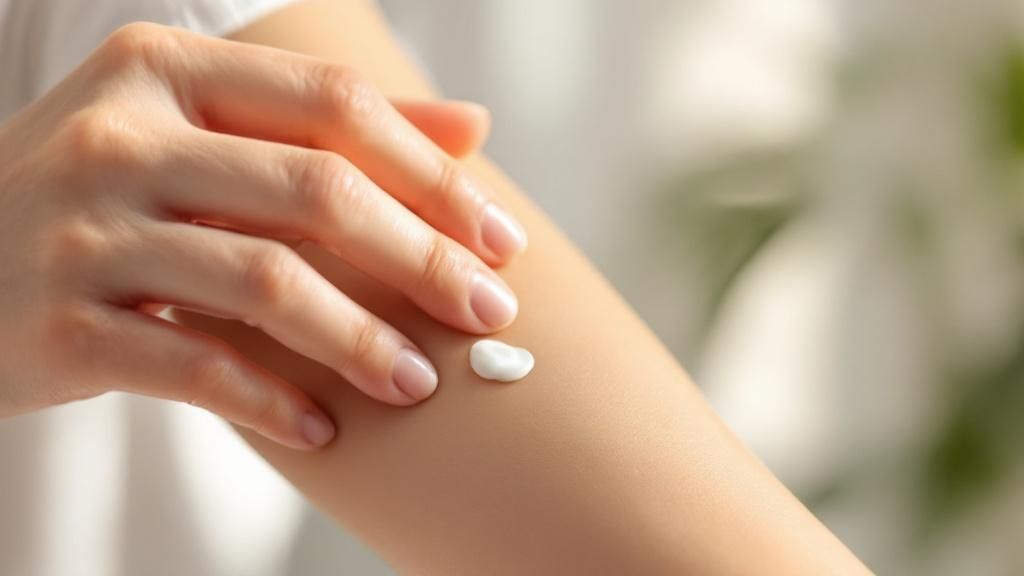
Sometimes, even the most diligent at-home care isn’t enough to get a stubborn wound across the finish line. When an injury heals too slowly, is particularly large, or carries a high risk of infection, it’s time to call in the heavy hitters.
Modern medicine offers some truly remarkable tools for these challenging situations. We're not talking about your standard drugstore bandages. These are highly specialized dressings and therapies designed to actively intervene in the healing process, giving your body the support it needs. Understanding these options is crucial, especially if you or a loved one is dealing with a complex wound like a diabetic ulcer, a severe burn, or a surgical site that just won't close.
The Power of Antimicrobial Dressings
In my experience, one of the biggest roadblocks to healing is the constant threat of infection. Bacteria can set up shop in a wound, forming a slimy shield called a biofilm that the body's own defenses struggle to break through. This is precisely where antimicrobial dressings become a game-changer.
These dressings are infused with powerful agents that either kill microbes or stop them from multiplying. Think of them as a frontline defense for wounds that are already infected or are dangerously close to becoming so.
- Silver Dressings: Silver has been a trusted antimicrobial for ages, and for good reason. Dressings infused with silver ions release them directly into the wound bed, where they disrupt bacterial cells and stop them from taking over. You'll often see these used for burns and infected surgical wounds.
- Medical-Grade Honey Dressings: Now, this isn't the stuff you put in your tea. Medical-grade honey, like Manuka honey, is sterilized and boasts incredible antibacterial and anti-inflammatory properties. It creates a moist, acidic environment that bacteria hate, and it also helps gently debride, or clean, the wound.
The right choice often comes down to the specifics of the wound. Is it draining heavily or is it relatively dry? A deep dive into different techniques, like the ones detailed in our guide to wet-to-dry wound care dressing changes, can shed more light on managing these varying conditions.
Demystifying Wound Biologics
When dressings aren't enough, the next level of care often involves wound biologics. The name sounds complicated, but the idea is simple: we use substances derived from natural biological processes to kick-start the body’s own repair mechanisms.
It's like calling in a team of specialists when your body's own healing crew is exhausted or overwhelmed. Biologics can provide the raw materials or send the critical signals needed to finally get the job done.
This isn't just a minor upgrade. For patients with chronic, non-healing wounds, biologics can be the one intervention that finally triggers closure and prevents more drastic outcomes, like amputation.
These advanced therapies typically fall into two categories:
- Skin Substitutes: These are incredible, engineered materials that act as a scaffold for new skin to grow upon. Whether derived from human tissue or created synthetically, they cover and protect the wound, providing a framework for the body's own cells to move in and start rebuilding.
- Growth Factors: These are topical gels or solutions packed with proteins that signal your cells to grow, divide, and get to work. Applying them directly to a wound is like sending an urgent memo to the repair cells, telling them to ramp up their activity—now.
These treatments are quickly becoming a cornerstone of modern wound management, especially in hospitals. The global market for wound care biologics was valued at USD 2.2 billion in 2024 and is expected to hit USD 3.6 billion by 2034. This surge is fueled by their proven success in treating tough cases like diabetic ulcers, venous leg ulcers, and surgical incisions, which accounted for 27% of the market. Hospitals, which make up nearly 44% of end-users, are leaning on biologics to heal patients faster, lower infection rates, and shorten hospital stays. This global shift shows how serious we are about finding ways to heal skin fast. You can review the full analysis of these market trends on gminsights.com.
Ultimately, these solutions offer real hope and tangible results for wounds that, in the past, might have lingered for months or even years. They represent a major leap forward in our ability to guide the body's incredible healing power.
Knowing When to Seek Professional Medical Help
While handling minor cuts and scrapes at home is a great skill, knowing your limits is even more important. You have to be able to recognize when a wound is more than you can handle with just a first-aid kit. Honestly, this is one of the most critical parts of learning how to heal skin fast—and safely.
Think of it like this: you can handle a small kitchen flare-up with a fire extinguisher, but you’d call 911 for a house fire without a second thought. The same principle applies here. Trying to tough out a serious injury can turn a manageable issue into a major health crisis.
Clear Signs You Need a Doctor
Some symptoms are your body's way of screaming for help. These aren't subtle hints; they're clear-cut warnings that it's time to let a professional take over.
Don't hesitate to seek medical attention if you see any of these signs:
- Bleeding That Won't Stop: If you've applied firm, direct pressure for a good 10-15 minutes and blood is still soaking through the bandages, it's time for the ER.
- Deep Puncture Wounds: An injury from something like a nail, a shard of glass, or an animal bite can be deceptive. It might not bleed a lot, but these wounds inject bacteria deep into the tissue, creating a high risk for nasty infections like tetanus.
- Signs of a Spreading Infection: I'm not talking about a little pinkness around the edges. Look for red streaks spreading out from the wound, pain that gets worse after the first 48 hours, thick yellow or green discharge, a foul smell, or if you start running a fever.
- A Gaping Wound: If a cut is wide open and you can't easily pull the edges together, it’s not going to heal well on its own. It almost certainly needs stitches, staples, or medical adhesive to close properly and minimize scarring.
- It Isn't Healing: Even a minor scrape should look noticeably better after a week. If it looks the same—or worse—something is wrong.
Understanding the type of injury is also key. Different wounds require different care, and a doctor can instantly tell what you're up against. You can learn more by reading the 6 types of wounds in our detailed guide to get a better sense of when a visit is non-negotiable.
When Underlying Conditions Change the Rules
For some folks, even a tiny cut or scrape requires a doctor's attention right away. Certain chronic health conditions can throw a wrench into the body's natural healing process, making professional management absolutely essential from day one.
Diabetes is a perfect example. Poor circulation and nerve damage (neuropathy) are common side effects. This means a small cut on the foot might not even be felt, but it can quickly escalate into a serious, non-healing ulcer that threatens the entire limb.
If you have one of these conditions, the "wait and see" approach is off the table.
- Diabetes: Any break in the skin, especially on the feet, needs to be checked by a healthcare provider immediately.
- Vascular Disease: Conditions that mess with blood flow, like peripheral artery disease, essentially starve a wound of the oxygen and nutrients it needs to repair itself.
- A Weakened Immune System: Anyone on chemotherapy, steroids, or other immunosuppressant drugs has a much harder time fighting off infection, making any open wound a significant threat.
In these situations, getting professional care isn't just about healing faster; it's about preventing life-altering complications. The scale of this problem is reflected in the global wound skin care market, which was valued at an estimated USD 9.28 billion in 2025 and is projected to hit USD 14.14 billion by 2035. This growth is driven by the rise in chronic wounds and an aging population, which you can read more about in this wound skin care market report on futuremarketinsights.com.
At the end of the day, trust your gut. If a wound just feels "off" or you're worried about it for any reason, getting a professional opinion is always the right call. It’s far better to be safe than to risk a serious complication down the road.
Common Questions About Healing Skin Fast
Even when you have a solid plan, it’s completely normal for questions to pop up as your skin heals. You might wonder if you’re doing everything right, or if there's some secret trick you’ve missed. Let's tackle some of the most common questions we hear from patients to give you confidence in your recovery.
Understanding these details can make a huge difference, especially when a wound is healing slowly. It’s a massive field—the global wound care market was valued at around USD 22.22 billion in 2025 and is expected to hit USD 30.48 billion by 2030. This growth shows just how many people are looking for better, faster ways to heal. You can dig into these wound care market trends on marketsandmarkets.com.
Do Home Remedies Like Honey or Aloe Vera Actually Work?
This is a classic. While many people swear by natural remedies, you have to separate the facts from the myths. Not all "natural" solutions are built the same, and some can cause more harm than good.
-
Medical-Grade Honey: Yes, this works, but there's a huge catch. The honey used in clinical settings is sterilized and packed with powerful antimicrobial properties. Grabbing the honey bear from your pantry and spreading it on a wound is a terrible idea. It can contain bacteria and spores that will lead straight to an infection.
-
Aloe Vera: This plant is fantastic for soothing minor sunburns or skin irritation because of its anti-inflammatory effects. But for open cuts or deeper wounds, you’re much better off with proven medical dressings. Aloe isn't sterile and won't create the ideal moist environment that a healing wound needs.
For reliable results, it's always safer to stick with products designed specifically for wound care.
Is It Possible to Completely Prevent Scarring?
Preventing a scar entirely is often out of our hands, but you can absolutely influence how a scar develops. Scarring is just a natural part of your body's repair job, and the final look of it depends heavily on your care routine.
Proper wound care is your number one scar-prevention tool. Keeping a wound clean, covered, and moist helps new skin cells build across the gap with minimal drama. The key is avoiding scabs, which are basically roadblocks to healing. Once the wound is closed, you can help the scar fade and flatten by gently massaging it with moisturizers and protecting it from the sun with SPF 30 or higher.
A Practical Tip: Whatever you do, don't pick at a scab or healing skin. It feels like you're "helping," but you're actually re-injuring the area, slowing down healing, and dramatically increasing the odds of a bigger, more noticeable scar.
How Does Smoking Affect Skin Healing?
Smoking has a devastating effect on your body's ability to heal itself. If you're serious about wanting to know how to heal skin fast, quitting smoking is one of the most impactful things you can do. The damage is both immediate and systemic.
Here’s a play-by-play of what’s happening inside your body:
- It Constricts Blood Vessels: Nicotine makes your blood vessels clamp down, slashing the flow of oxygen-rich blood to the wound. Without enough oxygen, the cells in charge of repair simply can't do their job.
- It Impairs Immune Cells: Smoking weakens your neutrophils—the white blood cells that act as your body's first line of defense against infection. This leaves your wound wide open to a bacterial invasion that can stop the healing process in its tracks.
- It Disrupts Collagen Synthesis: The chemicals in cigarette smoke directly interfere with the production of collagen, the protein that provides the very foundation for new skin. This results in weaker tissue and a much higher risk of the wound reopening.
The bottom line? Smoking sabotages your recovery at every single stage. If you're healing from an injury or surgery, there's no better time to get help quitting. Taking the right steps after you're discharged from the hospital is critical, and we've put together a ton of helpful advice in our guide to effective post-discharge wound care at home.
At Rapid Wound Care, we specialize in bringing expert medical treatment directly to you, ensuring you have the professional support needed for a fast and full recovery. If you're dealing with a stubborn wound, don't wait. Learn more about our at-home services at https://rapidwoundcare.com.

